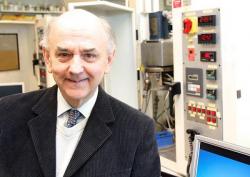With the world's energy sector constantly facing challenges, Western researcher Hugo de Lasa is working toward one solution for the beleaguered industry - a process of transforming agricultural waste into clean energy and valuable by-products.
"The problem is in areas where there is a lot of agricultural activity, such as wood processing, where you have wood waste or biomass," de Lasa said. "When you process natural products - wood, coffee or rice - you create this incredible amount of waste. What do you do with it? In Costa Rica, normally this waste was disposed in the fields, or thrown in the river. You have a problem."

Chemical and Biochemical Engineering professor Hugo de Lasa hopes his latest research project may lead to more efficient and environmentally sound processes in the conversion of renewable resources.
With coffee beans, for example, only 20 per cent of the plant is harvested. The remaining is waste.
So, what to do with that waste? de Lasa wants to put it to work.
Biomass materials include plant materials, residues from forest industries, by-products from wood manufacturing, agricultural waste products and even peels from citrus fruits. Energy from biomass continues to be underutilized, de Lasa said, and represents a tremendous opportunity for industry and individuals to take control of energy production costs and environmental impacts.
The Chemical and Biochemical Engineering professor is working with London-based KMW Energy Inc. on his project. The company engineers bioenergy systems to produce heat and energy for as sawmills, hospitals, schools, pulp and paper mills, power utility plants and greenhouses.
In tandem, the academic-corporate partnership aims to improve significantly the biomass conversion process, making it not only more economically competitive, but also, by reducing mono-nitrogen oxides (NOx) emissions, meet increasingly tougher environmental regulations.
de Lasa's idea is for a new Integrated CO2 Gasification + Chemical Combustion Looping (CO2G+CLC) process could help agricultural communities with a source of clean energy, biochar (a soil supplement) and concentrated CO2 for optimizing photosynthesis in greenhouse operations.
"(KMW's) strength is in building systems for combustion gasification of biomass," de Lasa said. "We are trying to see if there is an intersection of what we think, and the equipment they manufacture, and if it could be adapted to this innovative process. To go from the outcome of this project to implementing, this is where KMW comes in."
Natural Resources Canada's CanmetENERGY, comprised of 450 scientists, engineers and technicians looking at clean energy technologies, is also part of the de Lasa's project.
Natural Sciences and Engineering Research Council of Canada recently funded the project with a Strategic Project Grant, providing $370,950 over three years.
"As researchers, we are always trying to come up with innovations; we are always trying to connect ourselves to issues that require implementation, with a focus on industrial needs, a focus on financial viability," de Lasa said. "That's the way these things are going to permeate and become successful."
By Paul Mayne
Source: University of Western Ontario






